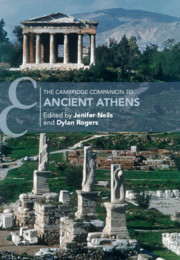Book contents
- The Cambridge Companion to Ancient Athens
- Cambridge Companions to the Ancient World
- The Cambridge Companion to Ancient Athens
- Copyright page
- Contents
- Contributors
- Abbreviations
- Athens: An Introduction
- 1 #Leagros: An Athenian Life
- Part I The Urban Fabric
- Part II Inhabitants
- Part III Business/Commerce
- 15 Labor and Employment
- 16 Piraeus: Harbors, Navy, and Shipping
- 17 The Archaeology of Markets and Trade
- 18 Coinage and Its Economic Implications
- 19 The Ceramic Industry
- 20 Sculpture and Its Role in the City
- Part IV Culture and Sport
- Part V Politics
- Reception
- Index
- References
20 - Sculpture and Its Role in the City
from Part III - Business/Commerce
Published online by Cambridge University Press: 10 March 2021
- The Cambridge Companion to Ancient Athens
- Cambridge Companions to the Ancient World
- The Cambridge Companion to Ancient Athens
- Copyright page
- Contents
- Contributors
- Abbreviations
- Athens: An Introduction
- 1 #Leagros: An Athenian Life
- Part I The Urban Fabric
- Part II Inhabitants
- Part III Business/Commerce
- 15 Labor and Employment
- 16 Piraeus: Harbors, Navy, and Shipping
- 17 The Archaeology of Markets and Trade
- 18 Coinage and Its Economic Implications
- 19 The Ceramic Industry
- 20 Sculpture and Its Role in the City
- Part IV Culture and Sport
- Part V Politics
- Reception
- Index
- References
Summary
This chapter deals with sculpture in Athens and Attica in the Archaic and Classical periods. Marble sculpture was introduced to Athens from the Cyclades in the late seventh century. Bronze became the dominant medium for sculpture from the late sixth century on.
- Type
- Chapter
- Information
- The Cambridge Companion to Ancient Athens , pp. 282 - 292Publisher: Cambridge University PressPrint publication year: 2021
References
Further Reading
For the functions of sculpture in Athens, see Palagia 2015a, along with Hochscheid 2015 on the production of sculpture and its impact on the Athenian landscape. On bronzes, see Mattusch 1988. For the early marble sculpture in Athens, see Sturgeon in Palagia 2006; Palagia 2010; Sturgeon in Palagia 2019. For Classical sculpture in Athens, see Palagia in Palagia 2006. For Athenian sculpture in Parian marble, see Palagia 2000. For the quarries on Mt. Penteli, see Korres 2000 and 2001. For workshops of marble sculptors in the Agora, see Lawton 2006 and Tsakirgis 2015. For reliefs, see Clairmont 1993, Lawton 1995a, and Comella 2002.
Bibliography
Additional resources to accompany this chapter can be found at: www.cambridge.org/NeilsRogers

